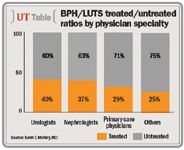Article
Two-thirds of BPH/LUTS patients don't receive meds
Author(s):
BPH and lower urinary tract symptoms are very common, increase as a function of age, and are often managed through watchful waiting.
Chicago-BPH and lower urinary tract symptoms are very common, increase as a function of age, and are often managed through watchful waiting, according to the results of an analysis presented at the AUA annual meeting.
Senior author Kevin T. McVary, MD, and colleagues at Northwestern University, Chicago, evaluated national patient claims data to assess the prevalence of non-surgical treatments for BPH/LUTS in the United States.
Among the key findings of the study was that up to two-thirds of the incidence of the disease goes untreated, defined in the study as men who were diagnosed but did not receive prescriptions for BPH/LUTS medications.

Dr. McVary's group used a dataset with medical and pharmacy information from 90 U.S. health care plans. Specifically, they focused on administrative claims data from October 2006 through September 2007. Patients were at least 45 years old with one or more appropriate diagnostic codes.
Prescription information was drawn from retail data, including chain stores and mass merchandisers, pharmacies, and food stores.
Medications used by men in the study included alpha-antagonists, 5-alpha-reductase inhibitors, and anticholinergics. Alpha-antagonists were the most commonly used drugs, taken by 84% of the men.
Specific drugs used were tamsulosin (Flomax, 49.7%), finasteride (Proscar, 17.1%), alfuzosin (Uroxatral, 14.3%), dutasteride (Avodart, 14.1%), terazosin (Hytrin, 14.0%), and doxazosin (Cardura, 13.2%).
Urologists more likely to treat
Of the 8,718,192 patients in the study population, 33.6% had BPH prescriptions filled, while 66.4% did not receive prescriptions. The percentage of treated men increased by age group: 19% for those 45 to 54, 28% for those 55 to 64, and 43% for those 65 and older (p<.001).
The treated/untreated ratio varied by specialty: 37%/63% for nephrologists, 29%/71% for primary care physicians, and 25%/75% for others. Interestingly, the treated/untreated ratio for urologists was 40%/60%, which Dr. McVary feels could be connected to the fact that patients with the most severe symptoms may be most likely to seek out a urologic specialist.
It was also observed that patients with a higher number of medical comorbidities were significantly more likely to be treated than those with fewer comorbidities (p<.001).
The researchers found that watchful waiting is often recommended by clinicians as an acceptable means of dealing with BPH/LUTS, prompting Dr. McVary to comment, "If the problem isn't prostate cancer, watchful waiting can be an effective way to help patients cope with symptoms."
Dr. McVary serves as an investigator/consultant for GlaxoSmithKline, sanofi-aventis, and Astellas.
Modern Medicine NETWORK
TOOLS
Educate your patients on BPH with this free handout at: http://www.urologytimes.com/BPHhandout
COMMUNITY
Use of intraprostatic injections to treat BPH is not a new idea, but it's been the subject of renewed interest of late. Read Dr. Michael O'Leary's Perspective at: http://www.urologytimes.com/Oleary
Newsletter
Stay current with the latest urology news and practice-changing insights — sign up now for the essential updates every urologist needs.
















